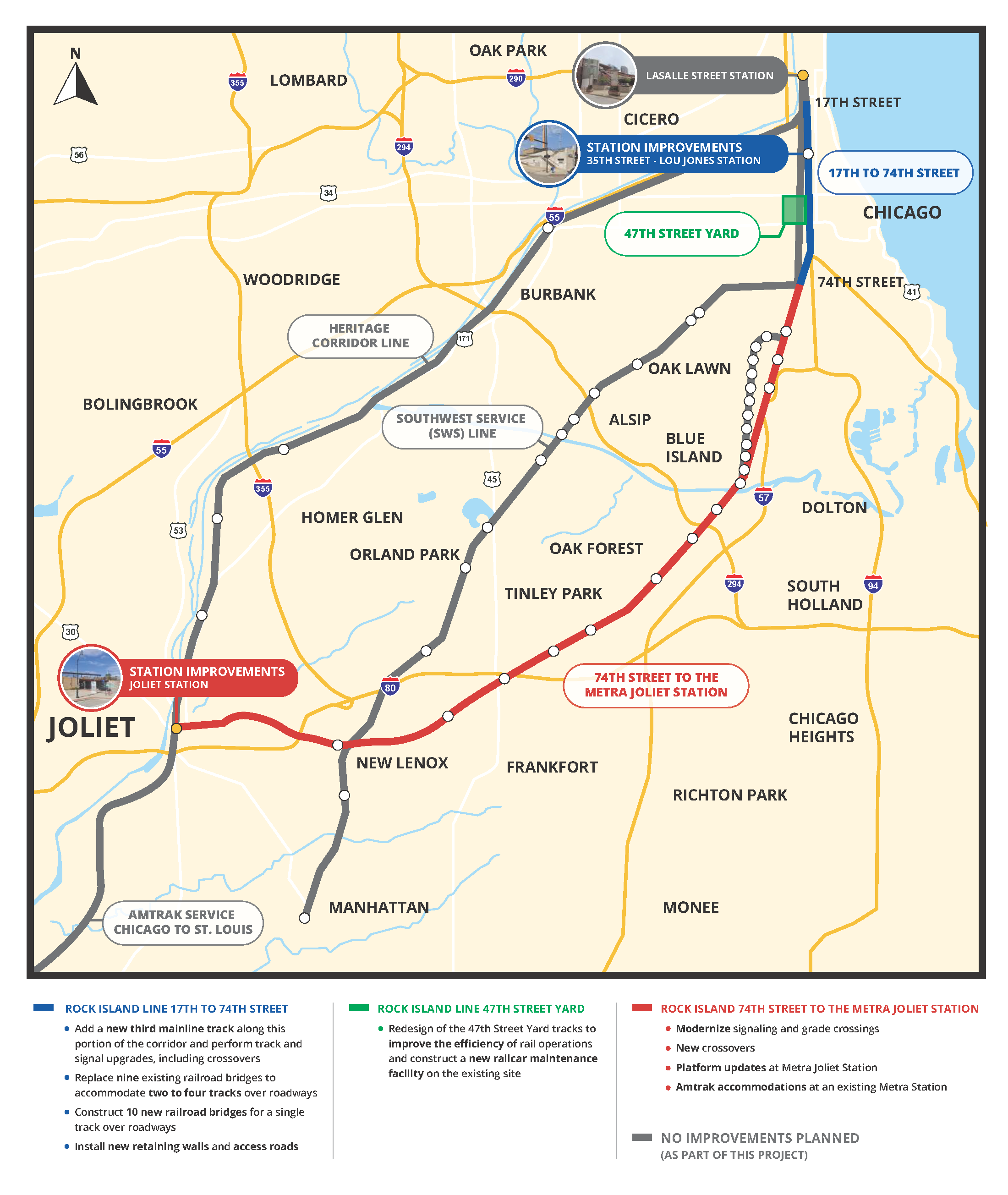Overview
The Rock Island Intercity Improvement Project (RI3 Project), led by Metra in partnership with Amtrak, would improve operations, add capacity, rehabilitate existing infrastructure, address maintenance needs and increase reliability of service for riders. The RI3 Project can be separated into three main sections:
The northern section extends from approximately 17th Street (just south of downtown Chicago, Illinois) to 74th Street, in Chicago, Illinois. This section would include the addition of a third mainline track and interlocking expansion from a connection with Metra’s SouthWest Service (SWS) line at 74th Street northward. The northern terminus is at approximately W. 17th Street, as there will already be a third mainline track north of that location. Work on this section would include:
- Adding a new third mainline track along this portion of the corridor and perform track and signal upgrades, including crossovers;
- Replacing nine existing railroad bridges to accommodate two to four tracks over roadways;
- Constructing 10 new railroad bridges for a single track over roadways; and
- Installing new retaining walls and access roads.
In addition, work planned for the 35th Street/Lou Jones Station would accommodate a third mainline track through the station and make Americans with Disabilities Act (ADA) improvements.
The middle section encompasses the reconfiguration of the 47th Street Yard to support train maintenance and midday storage and improve the Rock Island (RI) Line train maintenance and training facilities. The RI3 Project would redesign the 47th Street Yard tracks to improve the efficiency of rail operations and construct a new railcar maintenance facility on the existing site. This new facility would increase capacity for railcar and locomotive rehabilitation, enabling Metra to return railcars and locomotives into service more quickly.
The southern section extends from 74th Street to the Metra Joliet Station and would modernize signaling and grade crossings, Gresham Interlocking, five crossovers, and update access at the Joliet Station and an intermediate station whose location is to be determined. The southern project terminus is at Joliet Station, which is where the Metra RI Line terminates and where the RI Line right-of-way (ROW) ends.
From 74th Street south to the Joliet Station, new crossovers would be added to enable trains to move from one track to another at certain locations, and upgrades would be made to existing signal crossovers. Platform modifications are also planned for the Joliet Station to accommodate Amtrak train boarding. Most of the work on the RI3 Project would be performed within Metra’s existing ROW.
Further, an existing Metra station along the RI Line would be modified to accommodate a stop for Amtrak trains when service is moved over. Details regarding the location of this station would be considered as part of the RI3 Project’s current design and planning phase.
Project Area Map
RI Line Background
Metra’s RI Line extends 40 miles southwest from Chicago’s LaSalle Street Station to Joliet providing service to 26 stations between Cook and Will counties.
The RI Beverly Branch serves portions of the south side of Chicago and the city of Blue Island west of the mainline. No work is anticipated on the RI Beverly Branch as part of this Project. In 2019, passenger trips on the RI Line totaled 7.34 million, ranking fifth among the 11 Metra lines.
Both the RI Line and Metra’s Heritage Corridor Line terminate at the Joliet Station, which is also a stop for Amtrak’s Texas Eagle and Lincoln Service. Joliet is the only suburban transfer station serving multiple Metra lines and Amtrak routes.
Funding
The RI3 Project preliminary design and NEPA activities are funded by the Federal Transit Administration (FTA). Metra and its project partners will be exploring local, state and federal funding needed to advance the RI3 Project.
Timeline
The RI3 Project is currently in the design and planning phase. An environmental review process is being conducted in accordance with the National Environmental Policy Act (NEPA).
Final design is expected to take two years and would commence after the NEPA phase has been completed. Construction is expected to occur once final design is complete and funding has been secured.
Stay Informed
If you have a question, comment, or would like to subscribe to the project mailing list, please complete the form below.
